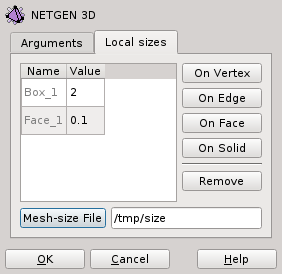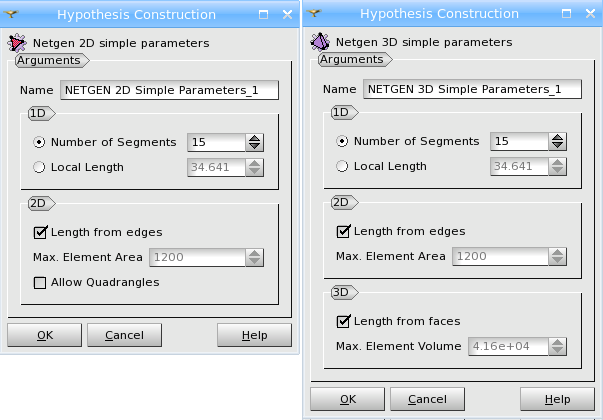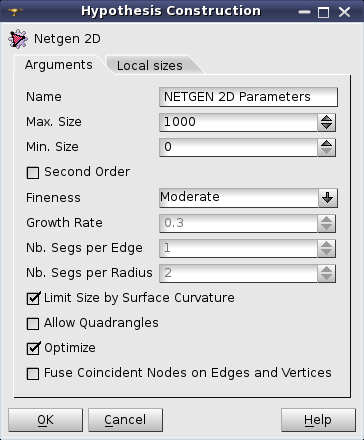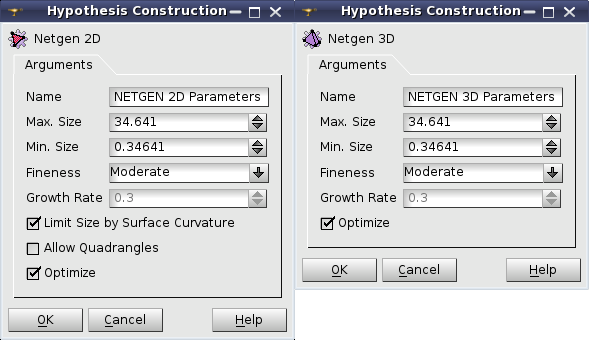NETGEN 2D Parameters and NETGEN 3D Parameters hypotheses work only with NETGEN 1D-2D, NETGEN 2D, NETGEN 1D-2D-3D and NETGEN 3D algorithms. NETGEN 1D-2D and NETGEN 1D-2D-3D algorithms do not require definition of lower-level hypotheses and algorithms (2D and 1D for meshing 3D objects and 1D for meshing 2D objects).
Hypothesis dialog boxes of NETGEN 1D-2D and NETGEN 1D-2D-3D algorithms are same
Dialog boxes of NETGEN 2D and NETGEN 3D algorithms
- Name - allows to define the name for the algorithm (NETGEN 2D (or 3D) Parameters by default).
- Max Size - maximum linear dimensions for mesh cells.
- Min Size - minimum linear dimensions for mesh cells. It is ignored if it is more than Max Size.
- Second Order - if this box is checked in, the algorithm will create second order mesh.
- Fineness - ranging from Very Coarse to Very Fine allows to set the level of meshing detalization using the three parameters below. You can select Custom to define them manually.
- Growth rate - allows to define how much the linear dimensions of two adjacent cells can differ (e.g. 0.3 means 30%).
- Nb. Segs per Edge - allows to define the minimum number of mesh segments in which edges will be split. This parameter is used only if Limit Size by Surface Curvature is checked.
- Nb Segs per Radius - allows to define the size of mesh segments and mesh faces in which curved edges and surfaces will be split. This value divided by a radius of curvature gives an element size at a given point. This parameter is used only if Limit Size by Surface Curvature is checked.
- Limit Size by Surface Curvature - if this box is checked in, then size of mesh segments and mesh faces on curved edges and surfaces is defined using value of Nb Segs per Radius parameter, and number of segments on straight edges is defined by values of Nb. Segs per Edge parameter. (Growth rate is also taken into account.) If this box is not checked in, then size of elements is defined by three parameters only: Max Size, Min Size and Growth rate.
- Allow Quadrangles - if this box is checked in, the mesher tries to generate quadrangle 2D mesh. Triangle elements are created where quadrangles are not possible.
- Optimize - if this box is checked in, the algorithm will modify initially created mesh in order to improve quality of elements. Optimization process is rather time consuming comparing to creation of initial mesh.
- Fuse Coincident Nodes on Edges and Vertices - allows merging mesh nodes on vertices and edges which are geometrically coincident but are topologically different.

- Local sizes - allows to define size of elements on and around specified geometrical objects. To define the local size it is necessary to select a geometrical objects in the object browser or in the viewer, and to click a button corresponding to the type of the geometrical objects: On Vertex, On Edge etc. Name of the geometrical object and a default Value will be added in the table where the Value can be changed.
- Remove - deletes a selected row from the table.
- Mesh-size File - opens a dialog to select a file defining size of elements. The file includes two obligatory sections. The first section defines the size at points. The second section defines the size along lines. Let's consider the following sample size file.
2
92.5 92.5 92.5 0.05
42.5 42.5 42.5 0.04
1
25 25 0 25 25 200 0.3
"92.5 92.5 92.5 0.05" at the second line means that at the point with coordinates (92.5, 92.5, 92.5) size of elements should be 0.05.
"1" at the fourth line means that there is one line in the second section.
"25 25 0 25 25 200 0.3" means that along the line between points (25, 25, 0) and (25, 25, 200) size of elements should be 0.3.

NETGEN 2D simple parameters and NETGEN 3D simple parameters allow defining the size of elements for each dimension.
1D group allows defining the size of 1D elements in either of two ways:
- Number of Segments allows specifying number of segments, that will split each edge, with equidistant distribution.
- Local Length defines length of segments.
2D group allows defining the size of 2D elements
- Length from edges if checked in, size of 2D mesh elements is defined as an average mesh segment length for a given wire, else
- Max. Element Area specifies expected maximum element area for each 2d element.
- Allow Quadrangles - allows to generate quadrangle elements wherever possible.
3D groups allows defining the size of 3D elements.
- Length from faces if checked in, the area of sides of volumic elements will be equal to an average area of 2D elements, else
- Max. Element Volume specifies expected maximum element volume of 3d elements.
- Note
- NETGEN algorithm does not strictly follow the input parameters. The actual mesh can be more or less dense than required. There are several factors in it:
- NETGEN does not actually use Number of Segments parameter for discretization of edge. This parameter is used only to define the local element size (size at the given point), so local sizes of close edges influence each other.
- NETGEN additionally restricts the element size according to edge curvature.
- The local size of segments influences the size of close triangles.
- The order of elements and their size in the 1D mesh generated by NETGEN differ from those in the 1D mesh generated by Regular_1D algorithm, resulting in different 2D and 3D meshes.



